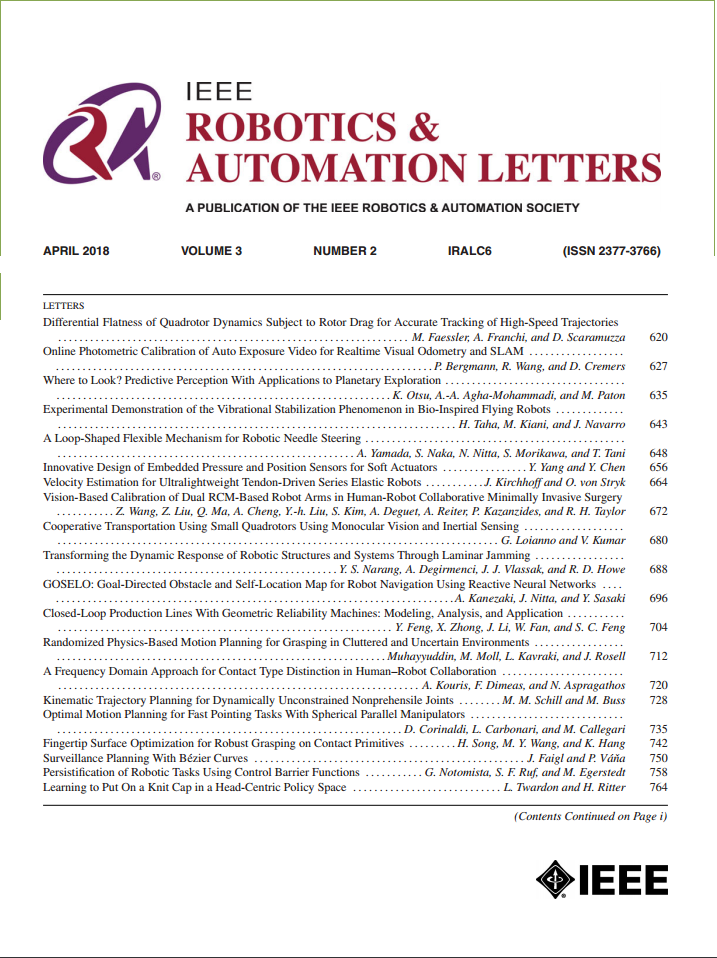VarWrist: An Anthropomorphic Soft Wrist With Variable Stiffness
IF 4.6
2区 计算机科学
Q2 ROBOTICS
引用次数: 0
Abstract
Robotic wrists play a crucial role in enhancing the dexterity and stability of robotic end-effectors. Existing rigid robotic wrists tend to be complex and lack flexibility, while soft robotic wrists often struggle with limited load-bearing capacity and lower accuracy. Human wrists feature multi-degrees of freedom and variable stiffness, which help human hands to accomplish daily tasks. This study presents an innovative anthropomorphic soft robotic wrist, VarWrist, equipped with a fiber jamming variable stiffness module, enabling stiffness adjustment through vacuuming. VarWrist consists of three parallel bellows, utilizing a positive-negative pneumatic actuation strategy to mimic human wrist motion. In addition, the trajectory equation of the rotation center was fitted through modeling. We developed a prototype of VarWrist and assessed its performance. Results indicate that the soft wrist surpasses the motion range of human wrists, achieving flexion (81.9°), extension (78.5°), ulnar deviation (70.5°), and radial deviation (70.5°). The bending motion trajectory showed a 73% increase in similarity to human motion compared to fixed-axis rotation, with VarWrist exhibiting a significant range of variable stiffness (resting state: 206%, working state: 155%). Demonstration experiments confirm that this wrist facilitates a dexterous hand in completing grasping tasks that would be unattainable by the hand alone.可变刚度的拟人化软手腕
机器人手腕在提高机器人末端执行器的灵活性和稳定性方面起着至关重要的作用。现有的刚性机器人手腕结构复杂,缺乏柔韧性,而柔性机器人手腕的承载能力有限,精度较低。人的手腕具有多自由度和可变刚度,帮助人的手完成日常任务。本研究提出了一种创新的拟人化柔性机器人手腕——VarWrist,它配备了光纤干扰变刚度模块,可以通过真空调节刚度。VarWrist由三个平行的风箱组成,利用正负气动驱动策略来模拟人类手腕的运动。此外,通过建模,拟合了旋转中心的轨迹方程。我们开发了VarWrist的原型并评估了它的性能。结果表明,软腕超过了人类手腕的活动范围,实现了屈曲(81.9°)、伸展(78.5°)、尺侧偏移(70.5°)和桡侧偏移(70.5°)。与固定轴旋转相比,弯曲运动轨迹与人类运动的相似性增加了73%,VarWrist显示出显著的可变刚度范围(静息状态:206%,工作状态:155%)。演示实验证实,这只手腕有助于灵巧的手完成单手无法完成的抓取任务。
本文章由计算机程序翻译,如有差异,请以英文原文为准。
求助全文
约1分钟内获得全文
求助全文
来源期刊

IEEE Robotics and Automation Letters
Computer Science-Computer Science Applications
CiteScore
9.60
自引率
15.40%
发文量
1428
期刊介绍:
The scope of this journal is to publish peer-reviewed articles that provide a timely and concise account of innovative research ideas and application results, reporting significant theoretical findings and application case studies in areas of robotics and automation.
 求助内容:
求助内容: 应助结果提醒方式:
应助结果提醒方式:


